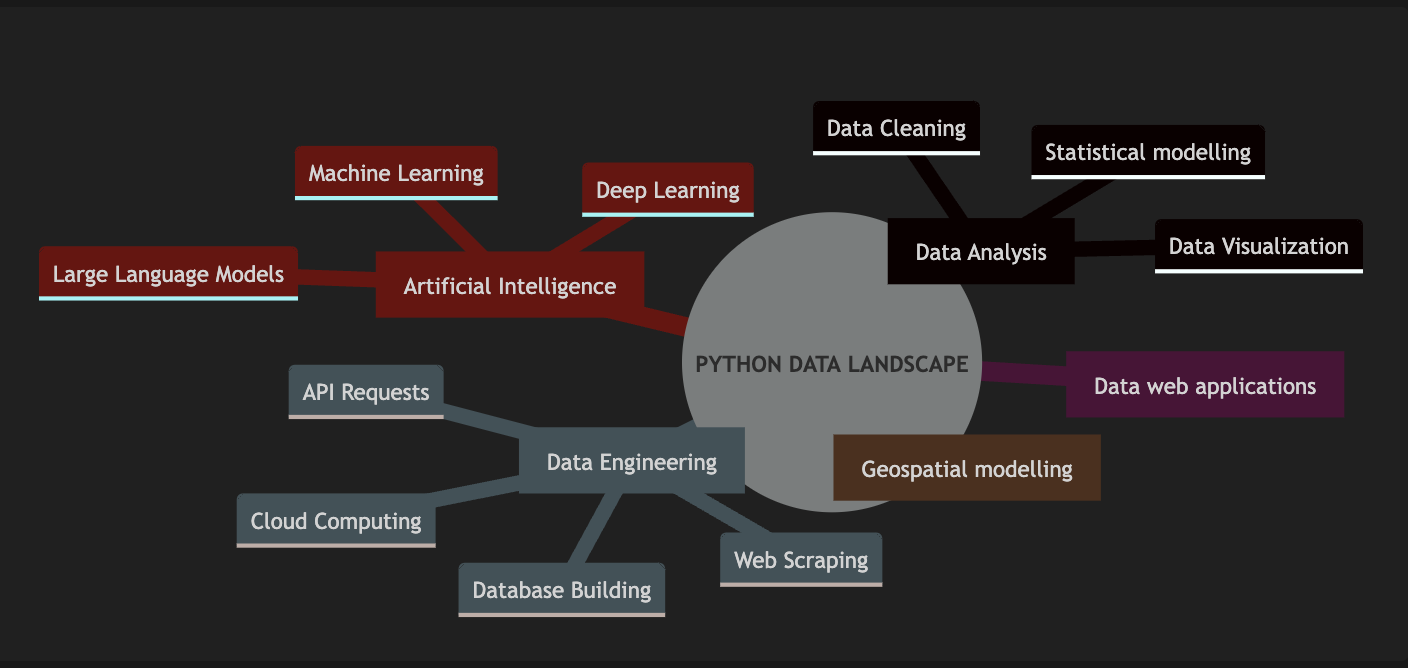Difference between revisions of "Python Landscape"
| Line 10: | Line 10: | ||
<imagemap> | <imagemap> | ||
Image:Python Landscape Diagram.png|frame|center | Image:Python Landscape Diagram.png|frame|center | ||
| − | rect 889 | + | rect 889 218 1076 286 [[Introduction to Pandas|Data Analysis]] |
</imagemap> | </imagemap> | ||
Revision as of 23:55, 22 July 2024
EDITION MODE. REFERENCES ARE MISSING. THERE ARE TYPOS.
Contents
- 1 Welcome to the Python Wiki for Data Analysis
- 2 What can you do with Python?
- 3 Why is it important to learn Python nowadays?
- 4 Why a Python Wiki when there are AI and numerous resources?
- 5 For whom is this Python wiki targeted?
- 6 Setting up your environment
- 7 Starting with Python basics
- 8 Doing some math with Python
- 9 Handling data in Python
- 10 Statistics with Python
- 11 Data Visualization
- 12 Machine Learning
- 13 Data Engineering
- 14 Data Storytelling
- 15 Project Management in Python
Welcome to the Python Wiki for Data Analysis
Python has become one of the most popular programming languages because of its simplicity, readability and versatility. It is a high-level, interpreted programming language created by Guido van Rossum and first released in 1991. Python emphasizes code readability and syntax that allows programmers to express concepts in fewer lines of code than possible in languages such as C++ or Java, therefore, for aspiring data analysts or scientists, Python represents a convenient entry into the programming world because it can be learned and mastered in a relative short period of time.
What can you do with Python?
With Python you can conduct simple and complex data analysis, design and launch websites, and even design artificial intelligence algorithms. This diagram is just a glimpse of the areas of application when working with python.
Why is it important to learn Python nowadays?
Python is widely used in industry, particularly in data science, web development, automation, and artificial intelligence. Learning Python opens up numerous career opportunities and it is now considered an essential component in data literacy.
Learning programming is now easier than before. There are hundreds with all books, websites, and communities that have been helping people to learn Python. As said above, this language is straightforward to learn which helps new programmers pick up the basics quickly.
Now with the emergence of Artificial Intelligence applications, learning programming has become less frustrating and more efficient. However, even without AI, Python has characterised by having a incredible documentation of all its libraries and frameworks. It only requires a quick google search to access the specific library documentation you need.
Why a Python Wiki when there are AI and numerous resources?
If you want to know how to start with Python, you would probably go to chatgpt, youtube, community blogs or other paid resources such as coursera, datacamp, etc. Although you can get very useful information and roadmaps from chatgpt and data scientists youtubers, there is a problem of consistency regarding the technical language they use and their approaches.
The team behind this wiki has had the same problem and navigated across hundreds of these resources. This wiki is bringing order to chaos, and to provide users a basic roadmaps that you can complement (with a critical perspective) with other materials on the internet.
Moreover, we are aware that Python is not perfect, and there are other programming languages such as R that can serve as a good complement. In this sense, this Python wiki is also linked to other R and statistical analysis entries.
For whom is this Python wiki targeted?
The purpose of this Wiki is to offer an overview and structured roadmap for those people who want to undertake their journey in Python and Data, for example:
- Students who are enrolled in courses where Python is the primary programming language used for data manipulation, analysis, and visualization. - Individuals who have some experience with R and want to understand the significance of Python and how it complements their existing skills. - Professionals from other fields looking to transition into data science. - Instructors who are teaching introductory programming, data science, or related fields will find these entries useful for explaining the importance and applications of Python to their students.
Setting up your environment
- Install and setup Anaconda
- Setting up Jupyter Lab
Starting with Python basics
- Conditions
- Loops
- Lists, Tuples, Sets, and Dictionaries
- Exceptions
- Functions
- Classes
- Objects
- Types, Expressions, and Variables
Doing some math with Python
Handling data in Python
Statistics with Python
- Binomial Distribution
- Bootstrapping
- Correlations
- Decision Trees
- Factor Analysis
- Linear Regression
- Multiple Regression
- Outlier Detection
- Poisson Distribution
- Regression, Correlation, and Ordinary Least Squares Estimator
Data Visualization
Data visualization is very important because...
Machine Learning
Data Engineering
Use of API Cloud computing

